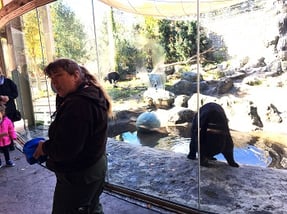A Blog About Understanding The Toyota Production System and Gaining Its Full Benefits, brought to you by "The Toast Guy"

Zoo Kata
 Senior Keeper Dayle Sullivan-Taylor demonstrates the enrichment process for NEIGC
Senior Keeper Dayle Sullivan-Taylor demonstrates the enrichment process for NEIGC
Last week I joined the New England Idea Generation Consortium (NEIGC) on a tour of the Stone Zoo where we had the opportunity to see how continuous improvement is expressed in an animal care function. In the open area for black bears, Senior Keeper Dayle Sullivan-Taylor explained to us the importance of animal enrichment. “It’s the best part of my job,” she said, “working with the animals on operant conditioning.” We watched as she coaxed one of the bears to stand and place first its front paws and then its face against the glass. “They’re very food-motivated,” she demonstrated, lofting food treats over the glass barrier as a reward for the bear’s response.
The behaviors the bears learn, referred to as “enrichment,” serve two purposes, first keeping their minds and bodies active and in learning mode; and second, as in this case, teaching them to stand at the edge of the barrier. “Behind the scenes,” Dayle explained, “the face behavior enables us to do many health checks and also give shots as needed without the need of anesthetizing the bears.” As Ms. Sullivan-Taylor described the regular pattern of exercise and small, constant increase in learning, I noticed a smile on the face of another of our consortium members, Jonathan Baum, a process improvement consultant at Brigham and Women’s Hospital. I think he and I simultaneously saw the similarity to Improvement Kata, a simple step-by-step routine for creating improvement, popularized in 2009 in the book Toyota Kata. Ms. Sullivan-Taylor continued. “We take very small steps with daily practice to enable the bear’s learning. After a while, the pattern becomes natural, however, and we only have to refresh once in a while.”
Next, our host described the importance of consistent behavior from the trainer. “Our role in interacting with the animals,” Dayle explained, “is critical to their learning. The Animal Training Advisor regularly observes my interaction with the bear and is able to see things that I miss. Her suggestions are helpful. And occasionally, we switch roles; she works with the bears and I observe her. It’s amazing how different that perspective is. I’ve learned a lot in that role too.”
At that point, Jonathan and I turned to each other and uttered, “Coaching Kata!” Ms. Sullivan-Taylor, without apparent awareness of the Kata concept, was now describing the coach’s role to support and develop enrichment, not only for the bears but also for the organization. Call it Zoo Kata,
O.L.D.
Want to learn more about Toyota Kata? Please join us on Tuesday, November 27 from 6:00-8:00 p.m. at GBMP offices in Newton for “Pizza Kata,” an overview & demonstration of Improvement Kata with Pizza for dinner. Registrants receive a free copy of Shingo Award-winning “Improvement Kata: Teaching Anna to Drive.” More information and registration here.